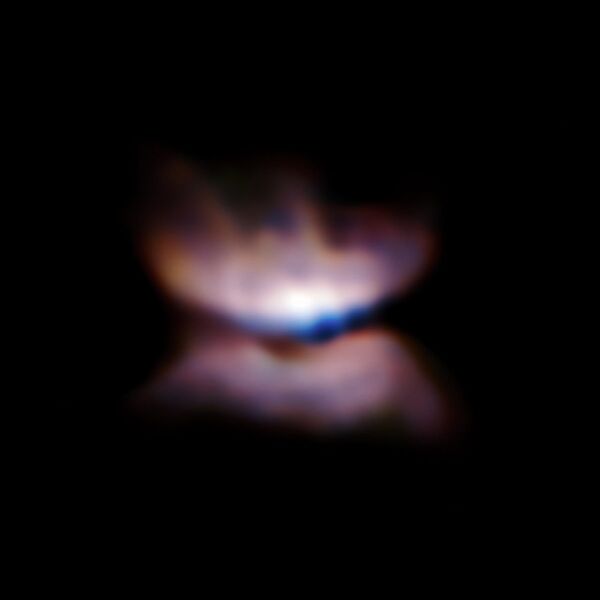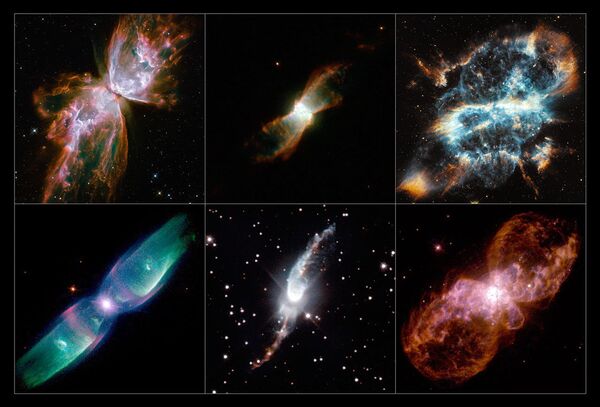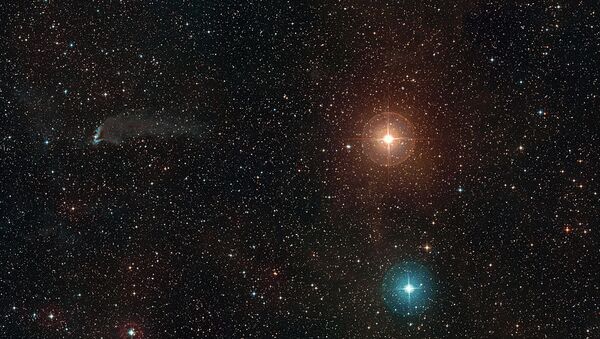The nebula centers on a red giant star called L2 Puppis. The red giant is dying and around it is a disk of dust that spans some 550 million miles (900 million kilometers). The butterfly shape is formed as cones of dust expand outward perpendicularly from either side of the disk formation.

The images, which were captured by the European Southern Observatory's Very Large Telescope, show that those outward plumes are being formed by the movements of a companion star — a younger red giant star — orbiting L2 Puppis once every few years.
Researchers also created a video that zooms through the images:
This type of formation is what scientists would expect to create the complex, hourglass figure of a bipolar planetary nebula, the origin of which researchers still know relatively little about. (The nebula doesn't actually involve any planets, the name is a holdover from earlier times when the roundness of the formation appeared planet-like to observers.)
"The origin of bipolar planetary nebulae is one of the great classic problems of modern astrophysics, especially the question of how, exactly, stars return their valuable payload of metals back into space — an important process, because it is this material that will be used to produce later generations of planetary systems," study lead author Pierre Kervella, of Unidad Mixta Internacional Franco-Chilena de Astronomía in France, said in a statement.
"With the companion star orbiting L2 Puppis only every few years, we expect to see how the companion star shapes the red giant's disk. It will be possible to follow the evolution of the dust features around the star in real time — an extremely rare and exciting prospect."
— Dushyant Patel (@Dushy4nt) October 3, 2014
Normally, this kind of formation would be difficult to observe, as the nearby star would outshine the details of the nebula. But the ESO's Very Large Telescope was aided by its SPHERE instrument. The instrument's ZIMPOL mode enhances those otherwise too faint details, and these are first published images using this mode, and the most detailed of a star in this state.
In addition to the action of the companion star, which creates the cone-shaped plumes, scientists also observed plumes of material inside the cones which they believe are formed by the interactions of the stars' stellar winds and radiation.
Mystery of Butterfly Formations
Scientists have long puzzled over the origins of bipolar planetary nebula and some of their strange features. For example, NASA scientists discovered that many of these nebulae are all similarly aligned within our galaxy.
"This really is a surprising find and, if it holds true, a very important one," Bryan Rees, of the University of Manchester in the United Kingdom, said in a statement when the researchers he led discovered the pattern using NASA's Hubble Space Telescope and the European Southern Observatory's New Technology Telescope (NTT).

"Many of these ghostly butterflies appear to have their long axes aligned along the plane of our galaxy. By using images from both Hubble and the NTT we could get a really good view of these objects, so we could study them in great detail."
The researchers studied 130 nebulae throughout the central bulge in the Milky Way galaxy and found that, while most were pretty randomly aligned, binary planetary nebulae were different, in that they were the same.
"The alignment we're seeing for these bipolar nebulae indicates something bizarre about star systems within the central bulge," Rees said. "For them to line up in the way we see, the star systems that formed these nebulae would have to be rotating perpendicular to the interstellar clouds from which they formed, which is very strange."


